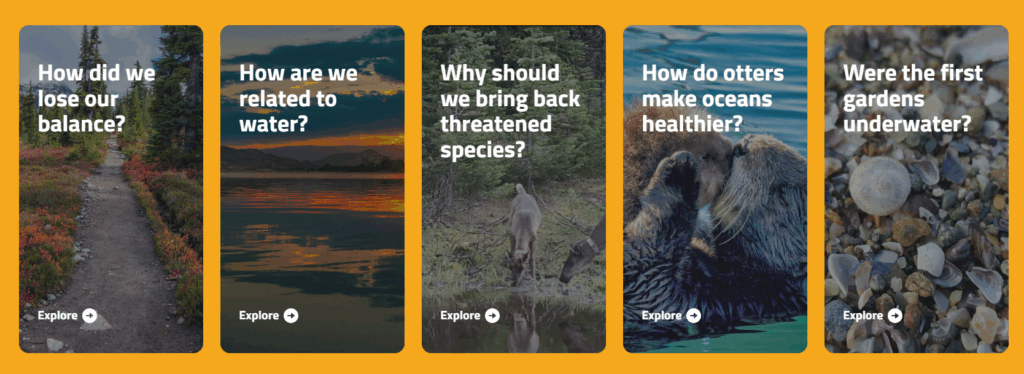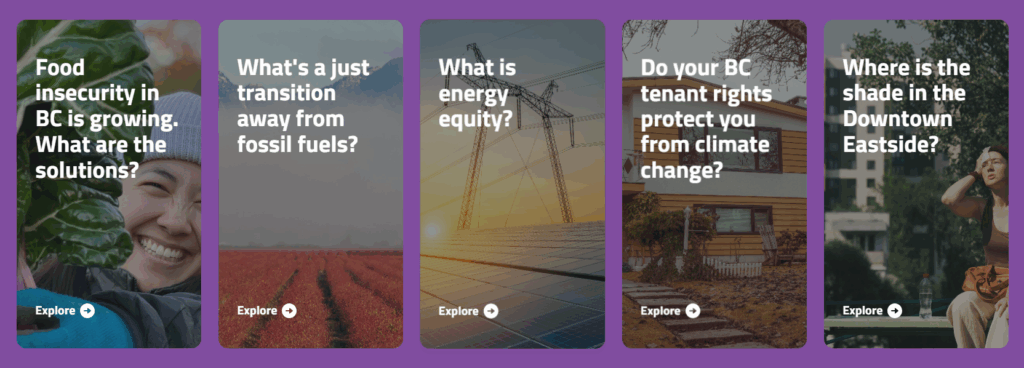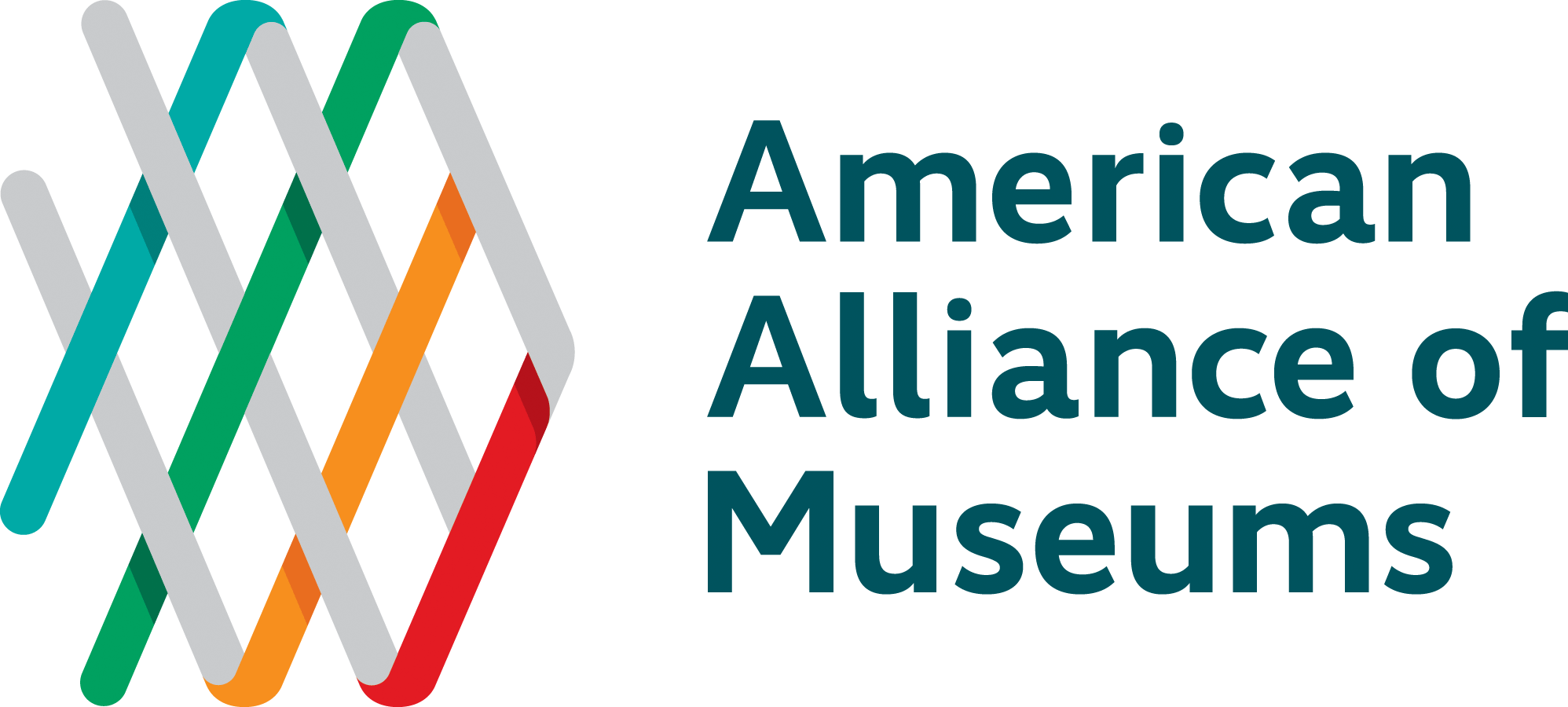Neugier auf das Klima wecken: Wie das Portal “Change Reaction” von Science World den Umweltdialog anregt

Nachhaltigkeit, Klimawandel und Umweltfragen sind dringende und komplexe Themen - dennoch ist es nach wie vor eine Herausforderung, Neugierde zu wecken und das Bewusstsein der verschiedenen Zielgruppen zu schärfen. Wissenschaftszentren, Bildungseinrichtungen und kulturelle Organisationen müssen oft kreative Schritte unternehmen, um als vertrauenswürdige, einflussreiche Stimmen zu fungieren, die Gemeinschaften auf sinnvolle und zugängliche Weise in die Diskussion einladen.
Welt der Wissenschaft, ein wissenschaftliches Zentrum mit Sitz in Vancouver, B.C., tut genau das. Durch seine Reaktion ändern Plattform hat Science World ein interaktives Online-Bildungszentrum geschaffen, das Lernende aller Altersgruppen in ganz Britisch-Kolumbien für STEAM - Wissenschaft, Technologie, Ingenieurwesen, Kunst und Design sowie Mathematik - begeistert und sich dabei auf Lösungen für einen regenerativen Planeten konzentriert. Das Portal ist in leicht verständliche Themen gegliedert, wie zum Beispiel Luft, Land, Natur, Energie, Technologie, und vieles mehr, was es den Besuchern leicht macht, die für sie wichtigsten Themen zu erkunden. Durch Artikel und Ressourcen bietet die Plattform Einblicke von Forschern, Wissenschaftlern und Gemeinschaftsorganisationen aus ganz Kanada und fördert so einen integrativen und gemeinschaftlichen Raum. Dadurch wurden mehrere Einstiegspunkte für das öffentliche Engagement geschaffen und gleichzeitig die Beziehungen zwischen den lokalen Gemeinschaften und Berufsgruppen gestärkt.


Kreative Sprache und interaktives Website-Design
Was setzt Reaktion ändern ist das durchdachte, spielerische Design und die klare, ansprechende Sprache. Artikelüberschriften wie “Wie machen Hamburger den Sommer heißer?” verwenden alltägliche Bezüge, um die Aufmerksamkeit zu wecken - vor allem bei einem Publikum, das aufgrund des Fachjargons vor wissenschaftlichen oder klimabezogenen Inhalten zurückschrecken könnte.
Die Artikel sind oft mit interaktiven Elementen wie Umfragen, Bildern mit ansprechenden Beschriftungen, unterhaltsamen Fakten und Fragen zum Nachdenken verknüpft. Am Ende einiger Artikel finden die Leser beispielsweise eine Frage wie: “Was denken Sie über das derzeitige Ausmaß des Klimawandels ... für die Ökosysteme und Arten des Planeten?” Die Antwortmöglichkeiten reichen von humorvoll bis ernsthaft, und sobald sie gestellt sind, können die Leser sehen, wie andere geantwortet haben - das fördert die Neugier, das Nachdenken und das Gefühl eines gemeinsamen Dialogs.

Verbindung von Wissenschaft, Geschichte und indigenem Wissen
Die Plattform bezieht auch die lokale Geschichte, die Sprache der Eingeborenen und die regionale Geografie mit ein, um die Klimabildung in der gelebten Erfahrung und im kulturellen Kontext zu verankern.
In dem Artikel “Wurde Dinosauriern im Winter kalt?”Die Plattform nutzt die Fantasie der Menschen und ihre Faszination für prähistorisches Leben, um den langfristigen Klimawandel zu erforschen. Sie vergleicht die heutigen Winterzyklen, die von Gletschereis und saisonaler Photosynthese geprägt sind und den CO₂-Gehalt beeinflussen, mit dem viel wärmeren, eisfreien Klima der Dinosaurierzeit. Außerdem wird veranschaulicht, dass der Meeresspiegel während der letzten Eiszeit 125 Meter niedriger war - “so hoch wie die meisten Gebäude in der Innenstadt von Vancouver” -, wodurch die abstrakten Daten anhand lokaler Wahrzeichen greifbarer werden.
In einem anderen Artikel, “Wird der Fraser River noch zu meinen Lebzeiten austrocknen?”erörtert die ethnografische Geowissenschaftlerin Shandin Pete, wie mündliche Überlieferungen und die Sprache der Eingeborenen wertvolle Einblicke in vergangene Klimabedingungen bieten. Pete erklärt, dass indigene Sprachen, die seit über 18.000 Jahren gesprochen werden, Umweltwissen kodieren. In dem Artikel wird zum Beispiel erwähnt: “In einer Sprache hieß der Monat Februar früher ‘so kalt, dass einem die Haare gefrieren’, aber dann änderte sich der Name und deutete darauf hin, dass die Wintermonate wärmer wurden.”

Verankerung von Gerechtigkeit in Klimalösung und -planung
Neben der Schärfung des Bewusstseins und der Vertiefung des Verständnisses für die Klimawissenschaft vermittelt Change Reaction den Lesern praktisches Wissen, das ihnen hilft, fundierte Entscheidungen zu treffen - vor allem, wenn es um ihre lokale Umwelt und ihre persönliche Sicherheit geht. Zum Beispiel, der Artikel “Was ist, wenn mein Haus in einer Überschwemmungszone liegt?” regt den Einzelnen dazu an, kritisch darüber nachzudenken, wie sich Klimarisiken - wie Überschwemmungen - nicht nur darauf auswirken, wo wir leben, sondern auch darauf, wie wir für die Zukunft planen. Es werden auch allgemeinere politische Anliegen hervorgehoben, indem betont wird, dass eine wirksame Klimaanpassung soziale Ungerechtigkeiten und die unverhältnismäßigen Auswirkungen auf marginalisierte Bevölkerungsgruppen berücksichtigen muss. Diese Überlegungen sind von entscheidender Bedeutung bei der Entwicklung von Strategien, die bei der Planung von Klimamaßnahmen den Schwerpunkt auf Vorsorge, Gerechtigkeit und langfristige Widerstandsfähigkeit legen.
Die Klimaaktionspläne in British Columbia entwickeln sich weiter, um nicht nur die Emissionen, sondern auch die Widerstandsfähigkeit der Gemeinden und die Gerechtigkeit zu berücksichtigen. In dem Artikel, “Wie werden Klimaaktionspläne konzipiert?“, Wie Dave Aharonian vom B.C. Climate Action Secretariat feststellt, wirkt sich der Klimawandel auf jeden Aspekt des Lebens aus - von der Infrastruktur bis zur öffentlichen Gesundheit. Städte wie Victoria nutzen Gefahrenkarten, um die Einwohner aufzuklären, während Vancouvers Resilient Neighborhoods Program die Bereitschaft der Bevölkerung unterstützt. Um gefährdete Bevölkerungsgruppen bei extremer Hitze zu schützen, bietet die Provinz kostenlose Klimaanlagen, aktualisierte Bauvorschriften und sogar ein Taxipilotprojekt für den Zugang zu Kühlzentren an - ein Beweis dafür, dass Klimalösungen umfassend und gemeinschaftsorientiert sein müssen.
Engagement als Schlüssel zur Klimabildung
Die zentralen Werte von Science World - Neugier, Spielfreude, Relevanz, Einbeziehung und Zusammenarbeit - ziehen sich durch alle Aspekte von Reaktion ändern. Durch die Kombination von zugänglicher Wissenschaftskommunikation und nutzerorientiertem Design informiert die Plattform nicht nur, sondern lädt die Besucher zum Nachdenken, Mitmachen und Handeln ein.
Dies ist genau die Art von Initiative, die vom Climate Toolkit unterstützt wird: Museen, Gärten, Zoos und andere Einrichtungen werden ermutigt, Klimabildung und -engagement in ihre alltäglichen Interpretationen und Programme zu integrieren. Science World bietet ein überzeugendes Modell dafür, wie digitale Plattformen eine Führungsrolle in Sachen Klima übernehmen können - eine Frage, eine Geschichte und ein neugieriger Besucher nach dem anderen.







Schreibe einen Kommentar